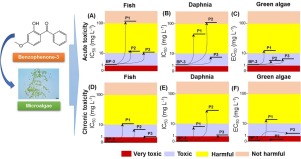当前位置:
X-MOL 学术
›
J. Hazard. Mater.
›
论文详情
Our official English website, www.x-mol.net, welcomes your
feedback! (Note: you will need to create a separate account there.)
Toxicity of benzophenone-3 and its biodegradation in a freshwater microalga Scenedesmus obliquus.
Journal of Hazardous Materials ( IF 12.2 ) Pub Date : 2020-01-20 , DOI: 10.1016/j.jhazmat.2020.122149 Sang-Hun Lee 1 , Jiu-Qiang Xiong 2 , Shaoguo Ru 3 , Swapnil M Patil 4 , Mayur B Kurade 4 , Sanjay P Govindwar 4 , Sang-Eun Oh 5 , Byong-Hun Jeon 4
Journal of Hazardous Materials ( IF 12.2 ) Pub Date : 2020-01-20 , DOI: 10.1016/j.jhazmat.2020.122149 Sang-Hun Lee 1 , Jiu-Qiang Xiong 2 , Shaoguo Ru 3 , Swapnil M Patil 4 , Mayur B Kurade 4 , Sanjay P Govindwar 4 , Sang-Eun Oh 5 , Byong-Hun Jeon 4
Affiliation

|
Environmental contamination by benzophenone-3 has gained attention because of its frequent occurrence and adverse environmental impact. Studies investigating the toxicity and removal mechanisms, along with its degradation pathway in microalgae are still rare. In this study, the ecotoxicity of benzophenone-3 on Scenedesmus obliquus was assessed through dose-response test, risk quotient evaluation, and changes of microalgal biochemical characteristics and gene expression. The calculated risk quotients of benzophenone-3 were >1, implying its high environmental risk. Expression of the ATPF0C and Tas genes encoding ATP-synthase and oxidoreductase was significantly increased in S. obliquus after exposure to benzophenone-3, while that of Lhcb1 and HydA genes was reduced. When exposed to 0.1-3 mg L-1 benzophenone-3, 23-29 % removal was achieved by S. obliquus, which was induced by abiotic removal, bioadsorption, bioaccumulation and biodegradation. Metabolic fate analyses showed that biodegradation of benzophenone-3 was induced by hydroxylation, and methylation, forming less toxic intermediates according to the toxicity assessment of the identified products. This study provides a better understanding of the toxicity and metabolic mechanisms of benzophenone-3 in microalgae, demonstrating the potential application of microalgae in the remediation of benzophenone-3 contaminated wastewater.
中文翻译:

二苯甲酮3的毒性及其在淡水微藻斜角藻中的生物降解。
由于苯甲酮-3的频繁发生和对环境的不利影响,已引起人们的关注。关于毒性和清除机制及其在微藻中的降解途径的研究仍然很少。在这项研究中,通过剂量反应试验,风险商评估以及微藻生化特性和基因表达的变化,评估了二苯甲酮3对斜生scenedesmus的生态毒性。计算出的二苯甲酮3的风险商> 1,表明其高环境风险。暴露于二苯甲酮3后,斜纹链球菌中的ATP合成酶和氧化还原酶的ATPF0C和Tas基因的表达显着增加,而Lhcb1和HydA基因的表达减少。当暴露于0.1-3 mg L-1二苯甲酮3中时,S可去除23-29%。非生物去除,生物吸附,生物蓄积和生物降解引起的倾斜。代谢命运分析表明,根据已鉴定产品的毒性评估,羟化和甲基化可诱导二苯甲酮3的生物降解,形成毒性较小的中间体。这项研究提供了对微藻中二苯甲酮3的毒性和代谢机理的更好理解,证明了微藻在处理二苯甲酮3污染的废水中的潜在应用。
更新日期:2020-01-21
中文翻译:

二苯甲酮3的毒性及其在淡水微藻斜角藻中的生物降解。
由于苯甲酮-3的频繁发生和对环境的不利影响,已引起人们的关注。关于毒性和清除机制及其在微藻中的降解途径的研究仍然很少。在这项研究中,通过剂量反应试验,风险商评估以及微藻生化特性和基因表达的变化,评估了二苯甲酮3对斜生scenedesmus的生态毒性。计算出的二苯甲酮3的风险商> 1,表明其高环境风险。暴露于二苯甲酮3后,斜纹链球菌中的ATP合成酶和氧化还原酶的ATPF0C和Tas基因的表达显着增加,而Lhcb1和HydA基因的表达减少。当暴露于0.1-3 mg L-1二苯甲酮3中时,S可去除23-29%。非生物去除,生物吸附,生物蓄积和生物降解引起的倾斜。代谢命运分析表明,根据已鉴定产品的毒性评估,羟化和甲基化可诱导二苯甲酮3的生物降解,形成毒性较小的中间体。这项研究提供了对微藻中二苯甲酮3的毒性和代谢机理的更好理解,证明了微藻在处理二苯甲酮3污染的废水中的潜在应用。











































 京公网安备 11010802027423号
京公网安备 11010802027423号